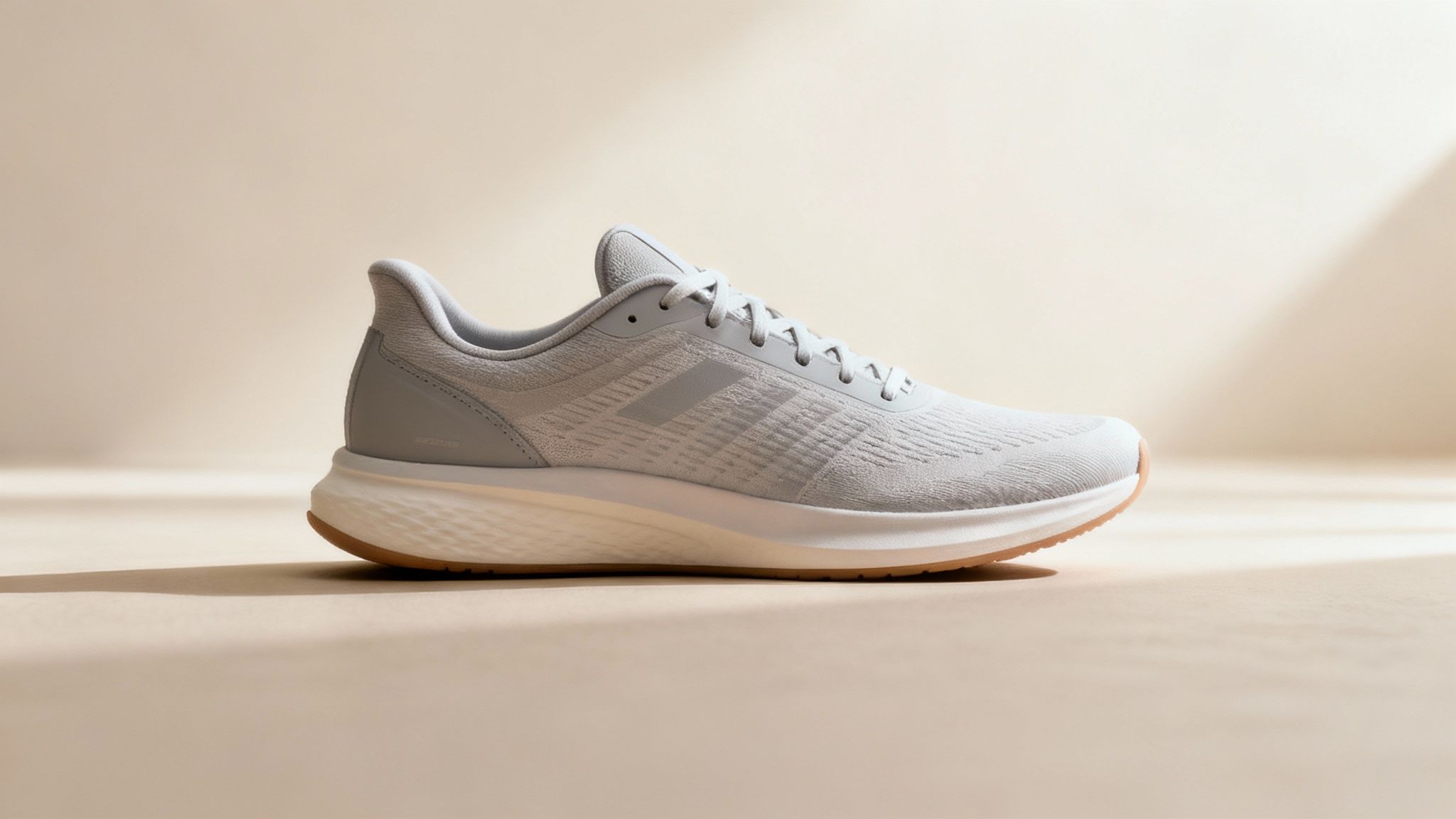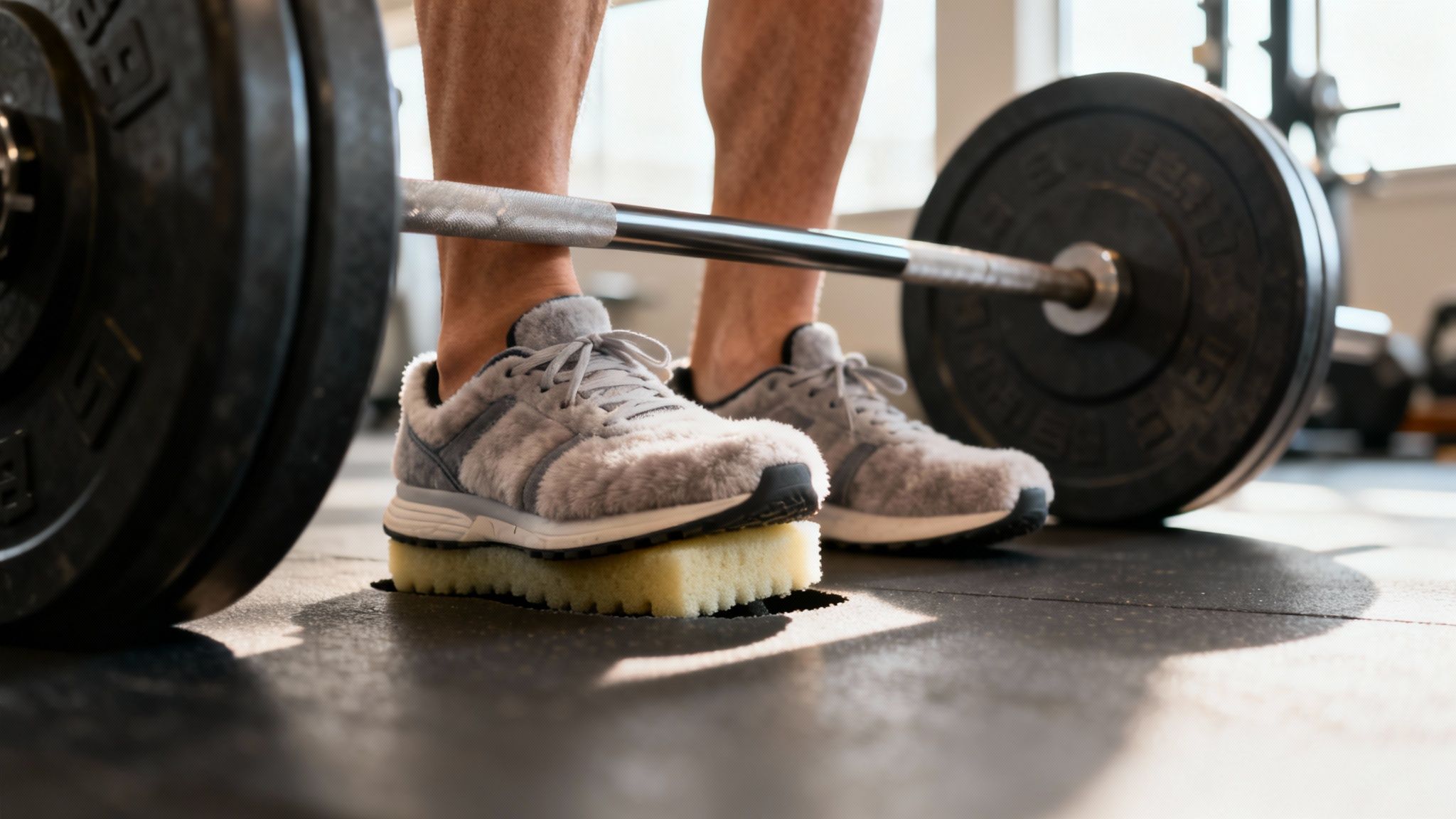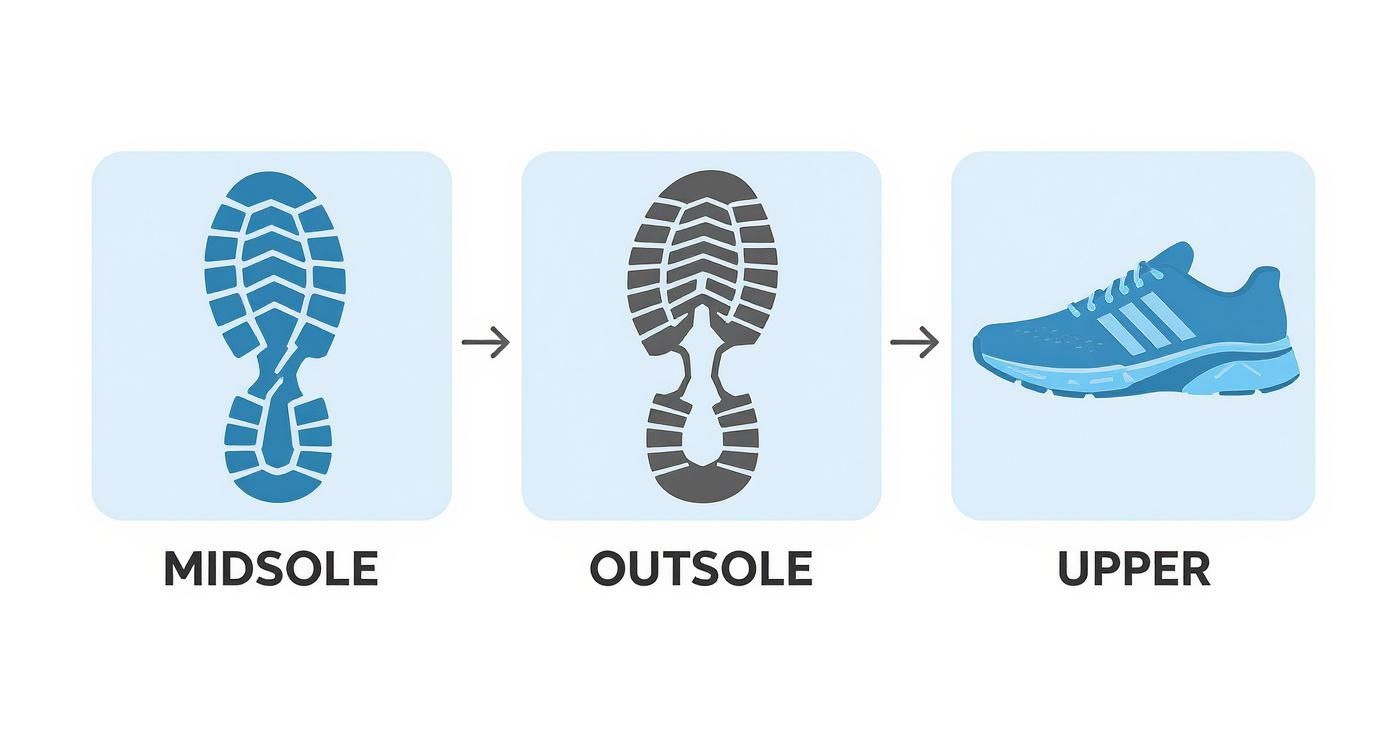The Ultimate Guide to Shoes for Weight Training and Cardio
- Flourish Everyday Health And Fitness

- 3 days ago
- 9 min read
Finding the single best pair of shoes for weight training and cardio involves balancing stability with responsive cushioning. Top cross-training shoes like the Nike Metcon, Reebok Nano, and NOBULL Trainer+ are popular for a reason: they provide a firm base for lifting while offering enough flexibility for cardio bursts like HIIT or treadmill sprints.
Decoding Your Ideal Hybrid Workout Shoe
The classic gym dilemma is finding one pair of shoes for both heavy lifting and dynamic cardio. Weightlifting demands a flat, stable foundation for safe power transfer, especially during compound movements like squats and deadlifts. Conversely, cardio activities like running require flexible cushioning to absorb impact and protect your joints. The secret to enhancing performance and preventing injury lies in finding a shoe that masters both.
This guide will help you select the perfect all-around performer. We'll analyze the critical features of a great hybrid shoe, from midsole firmness to outsole grip, so you can make an informed decision. For more curated lists and recommendations, check out our guide on top-rated athletic gear.
Navigating This Guide
To help you find your ideal shoe, we’ve broken down our analysis into these key sections:
Introduction
Why Running Shoes Undermine Lifts
Anatomy of a Great Cross-Training Shoe
Top Hybrid Shoes for Men & Women * Nike Metcon 9 * Reebok Nano X4 * NOBULL Trainer+ * On Cloud X 3
Matching Shoes to Your Workout Style
Health Information & Common Questions
Comparison of Wellbeing Trends: Minimalist vs. Cushioned Shoes
References

Top Hybrid Shoes at a Glance
For a quick overview, this table highlights our top-rated shoes for weight training and cardio, detailing their ideal workout scenarios and standout features.
Shoe Model | Best For | Stability Level | Cushioning Level | Key Feature |
|---|---|---|---|---|
Nike Metcon 9 | Lifting-focused workouts with short cardio bursts | High | Low | Hyperlift plate for heel stability |
Reebok Nano X4 | Balanced 50/50 lifting and HIIT routines | Medium-High | Medium | Lift and Run (L.A.R.) Chassis System |
NOBULL Trainer+ | Durability and versatile functional fitness | High | Low-Medium | Abrasion-resistant SuperFabric® upper |
On Cloud X 3 | Agility drills, HIIT, and light lifting | Medium | Medium | CloudTec® sole for responsive cushioning |
This table is your starting point. As we dive deeper, you'll gain a clearer understanding of which shoe best aligns with your specific training needs.
Why Running Shoes Undermine Your Lifts
Using plush running shoes for squats is a common gym mistake. While excellent for running, their soft foam and high heel drops create an unstable base for strength training. This mismatch can compromise form, reduce power, and increase injury risk during hybrid workouts.

Lifting in cushioned shoes is like squatting on a mattress. The soft surface compresses and causes instability, absorbing the force you're trying to drive into the ground. This "power leak" makes your lifts less effective. This instability is also dangerous, as it forces your ankles, knees, and hips to work overtime to maintain balance, leading to poor alignment and joint stress.
The Problem with Compression and Elevated Heels
The issue lies in the midsole. Running shoes are designed to absorb shock, not provide a rigid platform for force generation.
Midsole Instability: Thick, soft foam compresses under heavy loads, creating a wobbly surface and disrupting your connection to the floor.
Force Absorption: Cushioning soaks up energy instead of transferring it into the lift, diminishing your strength potential.
Altered Mechanics: Many running shoes have a high heel-to-toe drop, which can pitch your torso forward during squats and strain your lower back. A 2021 study highlighted how different heel heights in footwear significantly alter body posture and muscle activation during squats, reinforcing the need for a stable, low-drop shoe for lifting (1).
A stable, grounded connection to the floor is non-negotiable for safe and effective lifting. The 'sinking' feeling of squatting in running shoes is a clear signal that your footwear is undermining your strength and stability, not supporting it.
From Unstable Lifts to Potential Injury
Repetitive lifting on an unstable surface can lead to chronic issues. The constant micro-adjustments your joints make to compensate for shoe compression may contribute to tendonitis, ligament strain, and other overuse injuries. A proper training shoe provides the rigid, flat base needed for exercises demanding maximum stability. Finding the best shoes for weight training and cardio is about striking a balance: enough firmness for lifting without sacrificing all cushioning for cardio.
Anatomy of a Great Cross-Training Shoe
To find the best shoes for weight training and cardio, you must understand their core components. It boils down to a balance of stability, flexibility, and support. The global athletic footwear market's significant growth reflects a consumer shift towards versatile gear that can handle modern, multi-faceted workouts (2).
The Midsole: The Engine of Your Shoe
The midsole is the heart of a training shoe, balancing a firm platform for lifts with adequate cushioning for cardio. Cross-trainers use denser foam than running shoes to prevent compression under heavy loads, providing a stable base. However, a good midsole also needs flexibility in the forefoot to allow natural movement during dynamic exercises like box jumps or sprints.
The Outsole: Your Connection to the Ground
The outsole provides traction. For lifting, a flat, wide base maximizes contact with the floor for efficient power transfer. For cardio and agility, the outsole needs a multi-directional tread pattern for grip during quick movements. A durable rubber compound is essential to withstand abrasion from various gym surfaces and activities.
The Upper: Durable and Breathable Support
The upper wraps your foot, providing structure and support. Quality cross-trainers feature uppers made from tough, reinforced materials like engineered mesh to lock your foot in place during lateral movements. Breathability is also crucial to manage moisture and prevent blisters during intense workouts.
"The single most important technical spec for a hybrid training shoe is its heel-to-toe drop. A lower drop—typically 4mm or less—keeps your foot closer to a natural, flat position, which is superior for activating the posterior chain and maintaining proper form during heavy lifts."
This lower drop offers the grounded feel needed for weight training while remaining comfortable enough for cardio, making it the ideal compromise for a versatile athlete.
Top Hybrid Shoes for Men & Women
Here, we review the top hybrid shoes, focusing on their real-world performance in mixed-modality workouts. Finding the best shoes for weight training and cardio means understanding the trade-offs each model makes between stability and flexibility.
Nike Metcon 9 Performance Breakdown
The Nike Metcon 9 continues the series' legacy of stability. Its key feature is the large Hyperlift plate in the heel, which provides an exceptionally rigid platform for heavy lifting. During squats and deadlifts, this ensures a grounded, locked-in feel with minimal heel compression. However, this stability makes the shoe feel stiff during runs or dynamic cardio. The Metcon 9 is ideal for athletes whose routines are roughly 80% lifting and 20% cardio.
Lifting Scenario: Provides a rock-solid base under a heavy squat, allowing maximum power transfer.
Cardio Scenario: Feels clunky during sprints due to its rigid sole; best for short, explosive bursts.
Reebok Nano X4 In the Gym
The Reebok Nano X4 is designed as a true 50/50 hybrid. It features the Lift and Run (L.A.R.) Chassis System, with a dome-shaped heel piece that compresses for cushioning during cardio and flattens for stability during lifts. This technology makes it one of the most versatile options available. The Nano X4 offers solid stability for lifts—though not as locked-down as the Metcon—but excels in comfort and flexibility for HIIT and short runs. It's perfect for athletes who split their time evenly between strength and conditioning.
For a deeper dive, explore our comprehensive shoe reviews.
The Nano X4 represents a significant step toward solving the hybrid shoe dilemma. Its dual-density midsole successfully bridges the gap between the rigid stability needed for lifting and the responsive cushioning required for cardio.
The infographic below illustrates the key components of a high-performance cross-training shoe.

NOBULL Trainer+ Versus the Competition
The NOBULL Trainer+ prioritizes durability and a minimalist, grounded feel. Its standout feature is the seamless, one-piece SuperFabric® upper, which is highly resistant to abrasion from rope climbs and other high-wear movements. The firm, low-profile midsole offers excellent stability for lifting. The training shoe market is expanding rapidly, reflecting a trend toward durable, all-in-one gym footwear (3). While its firm base is excellent for strength work, the Trainer+ offers minimal cushioning, making it less suitable for high-impact activities. It best serves lifters who value durability and a close-to-the-ground feel.
Matching Your Shoes to Your Workout Style
The best shoe is one that supports your specific training style. General advice is a start, but performance gains come from matching shoe features to your gym routine. Since many people use one pair of shoes for all workouts—a trend reflected in market growth projections (4)—it's crucial to understand which profile fits your needs.
The Lifter Who Runs Sprints (80% Lifting, 20% Cardio)
Your priority is maximum stability. You need a shoe with a firm, flat midsole and a minimal heel-to-toe drop for heavy lifts.
Ideal Shoe Type: A stability-focused cross-trainer like the Nike Metcon.
Why It Works: These shoes feature a rigid heel and dense midsole that resist compression, ensuring force is directed into the lift. They sacrifice plush cushioning, as your cardio is limited to short bursts where a responsive forefoot is more valuable.
The HIIT and Agility Specialist
You need a shoe that is both agile and supportive for high-intensity intervals and explosive movements. Look for a blend of moderate cushioning, multi-directional grip, and lateral stability.
Ideal Shoe Type: A responsive trainer like the On Cloud X 3.
Why It Works: These shoes lock your foot in during lateral movements while offering forefoot flexibility and cushioning to handle the impact of high-rep plyometrics.
The Balanced 50/50 Athlete
Your routine is an even split between moderate strength training and sustained cardio. You need the most versatile shoe available.
Ideal Shoe Type: A balanced cross-trainer like the Reebok Nano X4.
Why It Works: These models use innovative midsole technology that is firm enough for moderate lifting yet flexible and cushioned enough for runs up to a few miles. They are the ultimate jack-of-all-trades.
Health Information & Common Questions
Navigating the world of hybrid footwear can be confusing. Here are answers to some frequently asked questions.
Can I just use one pair of shoes for everything?
Yes, a high-quality cross-training shoe is designed for this purpose. However, it's a compromise. A hybrid shoe won't offer the specialized stability of a weightlifting shoe or the plush cushioning of a dedicated running shoe. For the average gym-goer with a varied routine, a single pair of cross-trainers is a practical choice.
How often should I replace my workout shoes?
A good rule of thumb is every 300-500 miles of use, which for a regular gym-goer is typically every 6-12 months. Look for signs of wear: a compressed midsole that feels flat, a worn-out outsole with bald spots, or a frayed upper that no longer provides support. Don't wait for pain; replace shoes when their structural integrity is compromised to reduce injury risk.
What is the ideal heel-to-toe drop for a hybrid shoe?
A lower heel-to-toe drop, in the 0mm to 4mm range, is ideal. This keeps your foot in a more natural, flat position, which is crucial for a stable base during squats and deadlifts. A low drop improves your connection to the ground and helps activate the posterior chain.
Does the sock I wear matter?
Yes. Choose athletic socks made from moisture-wicking materials like polyester, nylon, or merino wool. These fabrics pull sweat away from your skin, preventing blisters. Avoid cotton, which absorbs moisture and can lead to friction.
Comparison of Wellbeing Trends: Minimalist vs. Cushioned Shoes
The debate between minimalist (low-drop, firm) and cushioned (high-drop, soft) shoes is a major trend in athletic footwear.
Minimalist Trend: Proponents argue that minimalist shoes promote a more natural foot motion, potentially strengthening foot muscles and improving biomechanics (5). The firm, stable base is highly advantageous for weight training, as it mimics barefoot lifting, which is considered the gold standard for power transfer. For cardio, it encourages a forefoot or midfoot strike, which some runners find more efficient.
Maximalist Cushioning Trend: This approach, popular in running, emphasizes shock absorption to reduce impact forces on joints. While beneficial for long-distance running, this level of cushioning creates instability and absorbs power during lifts, making it unsuitable for serious strength training.
Method Comparison: For the hybrid athlete, the optimal method is a middle ground. The best shoes for weight training and cardio adopt principles from the minimalist trend (low drop, stability) while incorporating enough targeted cushioning to make cardio comfortable and safe. This balanced approach supports overall well-being by protecting joints during impact without compromising form and safety during lifts.
References
Sato, K., Fortenbaugh, D., & Hydock, D. (2021). Kinematic changes using weightlifting shoes on an unstable surface. Journal of Strength and Conditioning Research, 35(1), 133-138.
Fortune Business Insights. (2023). Athletic Footwear Market Size, Share & COVID-19 Impact Analysis. Report No. FBI100257.
Allied Market Research. (2024). Training Shoes Market by Type, Distribution Channel, and End User: Global Opportunity Analysis and Industry Forecast, 2024-2035.
Technavio. (2024). Athletic Footwear Market in US 2024-2028.
Warne, J. P., & Gruber, A. H. (2017). Transitioning to minimal footwear: a systematic review of the evidence. Journal of Sports and Health Science, 6(3), 284-293.
At Flourish-Everyday, we're all about helping you find the perfect gear for your fitness journey. Check out our curated picks and deep-dive reviews to make your next choice with confidence. Visit us at https://www.flourish-everyday.com.
Comments